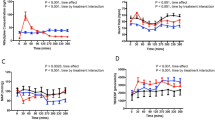Summary
The clinical syndrome of unstable angina includes patients with the first onset of angina, change in a previous stable pattern or the development of chest pain at rest. Administration of intravenous nitroglycerin is established therapy in unstable angina.
Buccal nitroglycerin has been introduced as an alternative means of administering nitroglycerin, which provides relief of anginal pain within 2 to 3 min and a sustained effect for 3 to 5 h. Twenty-nine patients admitted to the coronary care unit due to unstable angina were randomized to receive treatment with nitroglycerin i.v. for 24 h or buccal nitroglycerin every 4 h. Therapy was titrated according to haemodynamic effects.
The mean dose of buccal nitroglycerin was 4.42 mg versus 0.45 ug·kg−1·min−1 in the intravenous group. The efficacy of treatment was similar in the two groups. Buccal nitroglycerin appeared to cause fewer adverse effects, especially less haemodynamic intolerance and headache, although the differences were not significant.
Repeated administration of buccal nitroglycerin appears to be a safe and well tolerated alternative to high-dose i.v. nitroglycerin treatment in unstable angina pectoris.
Similar content being viewed by others
References
Fuster V, Chesboro JH (1986) Mechanism of unstable angina. N Engl J Med 315: 1023–25
Forrester JS, Litvack F, Grundfest W, Hickey A (1987) A perspective of coronary artery disease seen through the arteries of living man. Circulation 75: 505–513
Conti R (1987) Use of nitrates in unstable angina pectoris. Am J Cardiol 60: 31H-34H
Herling IM (1984) Intravenous nitroglycerin: clinical pharmacology and therapeutic considerations. Am Heart J 108: 141–149
Kaplan K, Davison R, Parker M, Przybylek J, Teagarden JR; Lesch M (1983) Intravenous nitroglycerin for the treatment of angina at rest unresponsive to standard nitrate therapy. Am J Cardiol 51: 694–697
Lichstein E, Greengart A, Hollander G, Sanders M, Cohen G (1982) Open study of safety and tolerability of nitroglycerin buccal controlled release tablet. Adv Pharmacol 1: 174–183
Abrams J (1983) New nitrate delivery systems: buccal nitroglycerin. Am Heart J 105: 848–854
Reichek N, Priest C, Kienzle M et al. (1982) Angina prophylaxis with buccal synchron nitroglycerin, a rapid onset long-acting nitrate. Adv Pharmacol 1: 143–154
Greengart A, Lichstein E, Hollander G et al. (1983) Efficacy of sustained release buccal nitroglycerin in patients with angina pectoris. Chest 83: 473–479
Ryde'n L (1987) Buccal versus sublingual glyceryltrinitrate administration in the treatment of angina pectoris. A Swedish multicentre study. Drugs 33 [Suppl] 4: 96–99
Lahiri A, Bowles M (1989) Buccal nitroglycerin and intravenous isosorbide dinitrate in unstable angina: A double blind study of acute administration. Am J Noninvas Cardiol 3: 281–289
Herlitz J, Hjalmarsson Å, Holmberg S et al. (1986) Variability, prediction and prognostic significance of chest-pain in acute myocardial infarction. Cardiology 73: 13–21
Herlitz J, Richter A, Hjalmarsson Å et al. (1986) Variability of chest-pain in suspected acute myocardial infarction according to subjective assessment and requirement of naroctic analgesic. Int J Cardiology 13: 9–22
HINT research group. (1986) Early treatment of unstable angina in the coronary care unit: a randomized, double-blind, placebo controlled comparison of recurrent ischemia in patients treated with nifedipin or metoprolol or both. Br Heart J 56: 400–413
RISK study group. (1989) ASA 75 mg and/or heparin after an episode of unstable coronary artery disease — risk for myocardial infarct and death in a randomized placebo-controlled study (abstract). Circulation 80: 1664
Theroux P, Ouimet H, McCans J et al. (1988) Aspirin, heparin, or both to treat acute unstable angina. N Engl J Med 319: 1105–1111
Telford A, Wilson C (1981) Trial of heparin versus atenolol in prevention of myocardial infarction in intermediate coronary syndrome. Lancet I: 1225–1228
Chatterjee K (1987) Role of nitrates in silent myocardial ischemia. Am J Cardiol 60: 18H-25H
Maseri A, Pesola A, Mazilli M et al. (1977) Coronary vasospasm in angina pectoris, Lancet II: 713–717
Jugdutt B, Warnica W (1988) Intravenous nitroglycerin therapy to limit myocardial infarct size, expansion, and complications. Circulation 78: 906–919
Author information
Authors and Affiliations
Additional information
Supported by a grant from AFA, The Labour Market Insurance Company, Stockholm, Sweden and by Hässle Cardiovascular Research Laboratories, Mölndal, Sweden
Rights and permissions
About this article
Cite this article
Dellborg, M., Gustafsson, G. & Swedberg, K. Buccal versus intravenous nitroglyerin in unstable angina pectoris. Eur J Clin Pharmacol 41, 5–9 (1991). https://doi.org/10.1007/BF00280098
Received:
Accepted:
Issue Date:
DOI: https://doi.org/10.1007/BF00280098




